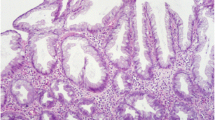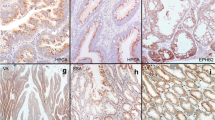Abstract
Aims
Known collectively as serrated polyps, hyperplastic polyps (HP), sessile serrated adenomas (SSA/SSP) and traditional serrated adenoma (TSA) may represent a spectrum of increasing malignant potential with characteristic immunological markers. There is increasing evidence that HP, SSA/SSP and TSA are biologically different and are likely to represent a spectrum along the serrated polyp pathway. Although there is general consensus about the diagnostic features of serrated polyps, the morphological differences between the categories are often subtle. This study compares the expression of p53 and P504S among serrated polyps. Sixty seven randomly selected biopsies (n = 59) and resection specimens (n = 8) histologically diagnosed for SSA/SSP, TSA and HP (19, 30 and 18 specimens, respectively) were obtained.
Methods and results
There was a significant difference in p53 (P < 0.001) and P504S (P < 0.001) immunopositivity and distribution among the serrated polyps. In particular, there is diffuse expression p53 and P504S in TSA compared to HP and SSA/SSP where p53 and P504S expression was more frequently confined to the lower 1/3 of the crypts. In addition, percentage of cells expressing p53 and p504S expression was higher in TSA than those of HP and SSA/SSP.
Conclusion
Immunostains, p53 and P504S, may be useful adjuncts to morphological diagnosis of serrated polyps.

Similar content being viewed by others
References
Vogelstein B, Fearon ER, Hamilton SR et al (1988) Genetic alterations during colorectal-tumor development. N Engl J Med 319(9):525–532
Kambara T, Simms LA, Whitehall VL et al (2004) BRAF mutation is associated with DNA methylation in serrated polyps and cancers of the colorectum. Gut 53(8):1137–1144
Higuchi T, Sugihara K, Jass JR (2005) Demographic and pathological characteristics of serrated polyps of colorectum. Histopathology 47(1):32–40
Li SC, Burgart L (2007) Histopathology of serrated adenoma, its variants, and differentiation from conventional adenomatous and hyperplastic polyps. Arch Pathol Lab Med 131(3):440–445
Farris AB, Misdraji J, Srivastava A et al (2008) Sessile serrated adenoma: challenging discrimination from other serrated colonic polyps. Am J Surg Pathol 32(1):30–35
Torlakovic E, Skovlund E, Snover DC, Torlakovic G, Nesland JM (2003) Morphologic reappraisal of serrated colorectal polyps. Am J Surg Pathol 27(1):65–81
Goldstein NS, Bhanot P, Odish E, Hunter S (2003) Hyperplastic-like colon polyps that preceded microsatellite-unstable adenocarcinomas. Am J Clin Pathol 119(6):778–796
Sheridan TB, Fenton H, Lewin MR et al (2006) Sessile serrated adenomas with low- and high-grade dysplasia and early carcinomas: an immunohistochemical study of serrated lesions "caught in the act". Am J Clin Pathol 126(4):564–571
Jass JR, Baker K, Zlobec I et al (2006) Advanced colorectal polyps with the molecular and morphological features of serrated polyps and adenomas: concept of a 'fusion' pathway to colorectal cancer. Histopathology 49(2):121–131
Makinen MJ, George SM, Jernvall P, Makela J, Vihko P, Karttunen TJ (2001) Colorectal carcinoma associated with serrated adenoma-prevalence, histological features, and prognosis. J Pathol 193(3):286–294
Goldstein NS (2006) Small colonic microsatellite unstable adenocarcinomas and high-grade epithelial dysplasias in sessile serrated adenoma polypectomy specimens: a study of eight cases. Am J Clin Pathol 125(1):132–145
Sawyer EJ, Cerar A, Hanby AM et al (2002) Molecular characteristics of serrated adenomas of the colorectum. Gut 51(2):200–206
Hiyama T, Yokozaki H, Shimamoto F et al (1998) Frequent p53 gene mutations in serrated adenomas of the colorectum. J Pathol 186(2):131–139
Schmitz W, Fingerhut R, Conzelmann E (1994) Purification and properties of an alpha-methylacyl-CoA racemase from rat liver. Eur j biochem/FEBS 222(2):313–323
Ferdinandusse S, Denis S, IJ L, Dacremont G, Waterham HR, Wanders RJ (2000) Subcellular localization and physiological role of alpha-methylacyl-CoA racemase. J Lipid Res 41(11):1890–1896
Jiang Z, Fanger GR, Banner BF et al (2003) A dietary enzyme: alpha-methylacyl-CoA racemase/P504S is overexpressed in colon carcinoma. Cancer detec prev 27(6):422–426
Zhou M, Chinnaiyan AM, Kleer CG, Lucas PC, Rubin MA (2002) Alpha-Methylacyl-CoA racemase: a novel tumor marker over-expressed in several human cancers and their precursor lesions. Am J Surg Pathol 26(7):926–931
Snover DC (2005) Serrated polyps of the large intestine. Semin Diagn Pathol 22(4):301–308
Spring KJ, Zhao ZZ, Karamatic R et al (2006) High prevalence of sessile serrated adenomas with BRAF mutations: a prospective study of patients undergoing colonoscopy. Gastroenterology 131(5):1400–1407
Chung SM, Chen YT, Panczykowski A, Schamberg N, Klimstra DS, Yantiss RK (2008) Serrated polyps with "intermediate features" of sessile serrated polyp and microvesicular hyperplastic polyp: a practical approach to the classification of nondysplastic serrated polyps. Am J Surg Pathol 32(3):407–412
DiSario JA, Foutch PG, Mai HD, Pardy K, Manne RK (1991) Prevalence and malignant potential of colorectal polyps in asymptomatic, average-risk men. Am J Gastroenterol 86(8):941–945
Torlakovic EE, Gomez JD, Driman DK et al (2008) Sessile serrated adenoma (SSA) vs. traditional serrated adenoma (TSA). Am J Surg Pathol 32(1):21–29
Goldstein NS (2006) Serrated pathway and APC (conventional)-type colorectal polyps: molecular-morphologic correlations, genetic pathways, and implications for classification. Am J Clin Pathol 125(1):146–153
Baker K, Zhang Y, Jin C, Jass JR (2004) Proximal versus distal hyperplastic polyps of the colorectum: different lesions or a biological spectrum? J Clin Pathol 57(10):1089–1093
Hamana T, Kawai K, Serizawa A, Tsutsumi Y, Watanabe K (1994) Immunohistochemical demonstration of p53 protein in colorectal adenomas and adenocarcinomas. Reliable application of the heat-induced antigen retrieval method to formalin-fixed, paraffin-embedded material. Pathol Int 44(10-11):765–770
Wu JM, Montgomery EA, Iacobuzio-Donahue CA (2008) Frequent beta-catenin nuclear labeling in sessile serrated polyps of the colorectum with neoplastic potential. Am J Clin Pathol 129(3):416–423
Dorer R, Odze RD (2006) AMACR immunostaining is useful in detecting dysplastic epithelium in Barrett's esophagus, ulcerative colitis, and Crohn's disease. Am J Surg Pathol 30(7):871–877
Chen ZM, Ritter JH, Wang HL (2005) Differential expression of alpha-methylacyl coenzyme A racemase in adenocarcinomas of the small and large intestines. Am J Surg Pathol 29(7):890–896
Author information
Authors and Affiliations
Corresponding author
Additional information
Sources of support: None declared
Rights and permissions
About this article
Cite this article
Ngo, NT., Tan, E., Tekkis, P. et al. Differential expression of p53 and p504s in hyperplastic polyp, sessile serrated adenoma and traditional serrated adenoma. Int J Colorectal Dis 25, 1193–1200 (2010). https://doi.org/10.1007/s00384-010-1007-5
Accepted:
Published:
Issue Date:
DOI: https://doi.org/10.1007/s00384-010-1007-5




